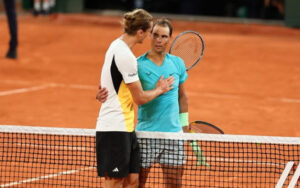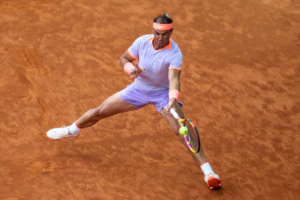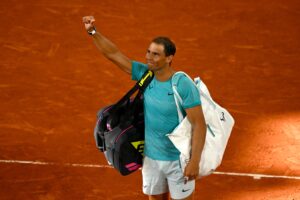
A smooth and stress-free entry into Roland Garros that is facilitated by a digital gantry, after which one can immediately pay homage to a metallic structure of a certain living legend, who has ruled the clay courts of this temple over the last 19 years.
To its right, there is an exhibition pickleball court, where young paddlers can entertain themselves to a new racquet sport that has taken the world by storm – maybe it’s a sign of things to come as, in a couple of decades, the next generation could be playing this competitively at the Grand Slams or at the Olympics.
After breaking some sweat, it is ideal to spend the next hour at the ‘Tenniseum’, that was designed by Bruno Moinard, the French architect, and launched in May 2003. The fascinating tennis museum will captivate any sports lover’s heart and intellect through its bilingual multimedia centre that hosts over 4,000 hours of content, as well as tennis artifacts, memorabilia and a mix of permanent and temporary collectibles.
Our favourite was the multimedia dashboard that one could touch and play around with to see the scorelines of the winners of the French Open over the decades and the physical propeller gun used by Roland Garros, the legendary war aviator after whom the stadium was named.
As you come out of the museum and walk another 50 metres, you would encounter the different sponsor booths showcasing their wares and any Indian tourist would feel proud to see and visit the Infosys stand that had a virtual reality game to engage the youngsters.
The sponsor hoardings also provide a good perspective of the changing macroeconomic landscape against which modern tennis is being played in the Open Era ~ alongside French giants such as BNP Paribas, Renault, Perrier and Lacoste, one witnesses the rising prowess of Asian giants like Emirates, Haier and Infosys.
Undoubtedly, it’s a tennis fan’s dream to watch a match on the hallowed courts of Philippe Chatrier, where we were fortunate to watch Stan Wawrinka convincingly go past Sir Andy Murray in straight sets, and local giant Gael Monfils take the wind out of Seyboth Wild with the help of a passionate crowd that backed him to the hilt. But the atmosphere outside on the public lawns was equally electrifying, where a few hundred of us were cheering for Rafael Nadal on the big screen in a picnic-like setup.
For the Latest Sports News: Click Here

The lucky ones were watching the game on comfortable hammock chairs and the rest of us used fashionable Roland Garros towels to make ourselves at home.
Our hero was on the back foot right from the start against Alexander Zverev, a 27-year-old rising stock, and we cheered our hearts out for every breakpoint saved; for every forehand crosscourt winner; for every lob that extended his life on the court and for every acrobatic skid that brought back memories of a lifetime.
Rafa, who has ruled Roland Garros as his kingdom over the last two decades may have bowed out as an unseeded contestant in Round 1 this year, but he lived up to the motto that is inscribed on the hallowed walls of the court he valiantly and tenaciously competed in – “Victory belongs to the most tenacious”.
What made this experience even more enjoyable as fans was that we could nibble and sip onto whatever we liked – I enjoyed a cup of doppio from the fancy Lavazza outlet that embossed their hot drinks with Roland Garros emblem whilst my mates had a good time with their Moet & Chandon champagnes and some savoury crepes. French indulgence at its best!
Earlier in the day, whilst waiting for the Nadal encounter with bated breath, we had a fabulous opportunity to watch and support the solitary Indian competing at the French Open this year. Sumit Nagal, who beat 31st seeded Alexander Bublik at the Australian Open earlier this year to make it to the second round, was up against the 18th seeded giant Karen Khachanov on Court 7.
There is a different charm in watching a game from close quarters on a smaller court, as not only does one see their heroes in proximity but one also appreciates the pace of the serves, smashes and rallies. It also becomes much easier to spot and catch the players post the game for a quick selfie and autograph.
Beyond the game, what makes a clay court affair even more romantic is when you witness the ground staff prepare the court, be it the uniform leveling of the soil or the watering to keep it moist – it is a sight to cherish and behold.

While the fans can’t step on to the clay court themselves, they can indulge in a good photograph against the backdrop of a large Roland Garros-embossed wall that is beautifully designed and decorated with clay; likewise there is a Perrier-sponsored nature wall adorned with foliage that makes for a fabulous photo spot.
The rains definitely played spoilsport in the early parts of the tournament, but the organisers have ensured that every rain break can be enjoyed under the shade of a large parapluie [umbrella], with a cup of lemon-garnished Spritz, a box of mixed nuts and an array of multi-colored macaroons.
One can’t leave the compound without visiting one of the boutiques to take back a piece of history, or a souvenir for their loved ones. We were spoilt for choice with Nadal-branded tees, vests, jackets and caps, to other branded hoodies, shoes, towels, magnets and pens.
The most tastefully designed memorabilia and apparel were the tennis tees that had customised artwork for each year of the French Open imprinted on the fore. One could further personalise it with automated embroidery embossed within minutes of one’s purchase.
The French Open beautifully balances its heritage and sustainable practices with modern, tech-enabled facilities; it offers fresh recycled borewell water options encouraging fans to carry and fill their own cups and bottles with fresh drinking water.
Furthermore, everyone is encouraged to return their plastic cups and glasses at a designated return counter, where one can claim one’s plastic deposit via cash or card.
Beyond the majestic, high-quality tennis that one enjoyed on the clay courts, what was amply clear was that a sporting tournament of this stature also made a statement that sport at the end of the day is all about the fan’s experience. It’s about their education and entertainment; it’s about taking a stance on inclusion and sustainability and, most importantly, closely tied to a nation’s heritage, culture and legacy.
As a sporting fan and enthusiast, I am taking back bags full of memories created with my friends and family, and I silently hope that administrators back home will pay heed to the standards set at these iconic, global events and see these as benchmarks to cross as India aspires to host global multi-sporting events in the coming decades.
Also Read: Iga Swiatek survives Naomi Osaka magic in epic French Open clash